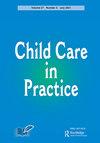Can Social Workers Forecast Future Actions, Events, and Outcomes? A Study of Referrals to Children’s Services in England
IF 1.4
Q3 FAMILY STUDIES
引用次数: 2
Abstract
Child protection social workers in England are required to make many decisions in their day-to-day work, including whether to accept a referral, undertake a child protection investigation, pursue care proceedings, or close the case. Many of these decisions involve implicit or explicit predictions about the likelihood of future actions, events, and outcomes. This paper presents the results of a study in which social workers and social work students in England were asked at two time points, six to eight months apart, to read a series of case vignettes and make forecasts about the likelihood of different actions, events, and outcomes. The accuracy of these forecasts was measured to determine 1) the aggregate level and range of forecasting accuracy, 2) whether forecasting accuracy is stable over time, 3) whether different vignettes are harder or easier to forecast and 4) whether personal or professional factors are predictors of forecasting accuracy. On average, respondent’s forecasts were 6% better than you would expect by chance, although there was significant variation within the sample. Nearly three-quarters of the respondents who made forecasts more accurately than chance at Time 1 did so again at Time 2. Four of the vignettes were found to be consistently easier to forecast, and four were consistently more difficult. No personal or professional characteristics were found to be significant predictors of forecasting accuracy. There are few straight-forward decisions in social work and the question of how best to support practitioners as they undertake this critical aspect of their role will continue to be an important focus for research.社会工作者能预测未来的行动、事件和结果吗?英国儿童服务转介研究
英格兰的儿童保护社会工作者在日常工作中需要做出许多决定,包括是否接受转介、进行儿童保护调查、进行护理程序或结案。其中许多决策涉及对未来行动、事件和结果的可能性的隐含或明确预测。本文介绍了一项研究的结果,在该研究中,英国的社会工作者和社会工作学生被要求在相隔六到八个月的两个时间点阅读一系列案例小插曲,并对不同行动、事件和结果的可能性做出预测。测量这些预测的准确性是为了确定1)预测准确性的总体水平和范围,2)预测准确性是否随着时间的推移而稳定,3)不同的小插曲是更难预测还是更容易预测,以及4)个人或专业因素是预测准确性的预测因素。平均而言,受访者的预测比你预期的要好6%,尽管样本中存在显著差异。在时间1做出预测的受访者中,近四分之三的人在时间2再次做出预测。其中四个小插曲被发现总是更容易预测,四个总是更难预测。没有发现任何个人或专业特征是预测准确性的重要预测因素。在社会工作中,很少有直接的决定,如何最好地支持从业者履行这一关键方面的职责,这一问题将继续成为研究的重要焦点。
本文章由计算机程序翻译,如有差异,请以英文原文为准。
求助全文
约1分钟内获得全文
求助全文
来源期刊

Child Care in Practice
Nursing-Community and Home Care
CiteScore
3.30
自引率
5.30%
发文量
32
期刊介绍:
Child Care in Practice is a quarterly, peer-reviewed journal that provides an international forum for professionals working in all disciplines in the provision of children’s services, including social work, social care, health care, medicine, psychology, education, the police and probationary services, and solicitors and barristers working in the family law and youth justice sectors. The strategic aims and objectives of the journal are: • To develop the knowledge base of practitioners, managers and other professionals responsible for the delivery of professional child care services. The journal seeks to contribute to the achievement of quality services and the promotion of the highest standards. • To achieve an equity of input from all disciplines working with children. The multi-disciplinary nature of the journal reflects that the key to many successful outcomes in the child care field lies in the close co-operation between different disciplines. • To raise awareness of often-neglected issues such as marginalization of ethnic minorities and problems consequent upon poverty and disability. • To keep abreast of and continue to influence local and international child care practice in response to emerging policy. • To include the views of those who are in receipt of multi-disciplinary child care services. • To welcome submissions on promising practice developments and the findings from new research to highlight the breadth of the work of the journal’s work.
 求助内容:
求助内容: 应助结果提醒方式:
应助结果提醒方式:


